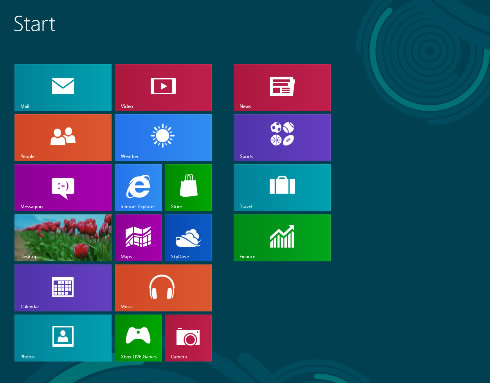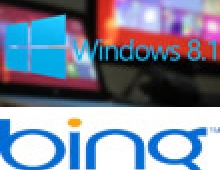
Microsoft Windows 8 Preview Released
Microsoft has officially released Windows 8 Release
Preview, the next milestone of Windows 8 operating
system.
Available for download today in 14 languages at
http://preview.windows.com, the Windows 8 Release
Preview delivers a new user interface that responds to
touch as it does to keyboard and mouse.
Windows 8 Release Preview delivers new apps from Microsoft and its partners. Highlights include Bing Travel, News and Sports apps, as well as Gaming and Music Xbox apps that integrate with your Zune pass. The Windows 8 Release Preview also features improvements to the Mail, Photos and People apps that initially debuted with the Windows 8 Consumer Preview. In addition, Microsoft has worked with its partners to deliver apps from around the world through the Windows Store.

Other refinements across the product include increased personalization options for the Start screen, improved multimonitor support, refinements to the way people find and download apps through the Windows Store, and new Family Safety features.
A touch-friendly and power-optimized Adobe Flash Player is now integrated into Internet Explorer 10, and it is also the first browser to feature Do Not Track "on" by default.
Below is a summary of key changes of to IE10 from the Consumer Preview
- Improved touch: full independent composition for real web sites (including fixed elements, sub-scrollers, animations, and video)
- Smoother UI transitions and animations with less flicker on low-end hardware
- Support for subset of Flash in Metro style IE for top sites for media playback and gaming
- Support for full-screen HTML5 video, including double-tap zoom to full-screen
- Improved layout for site selection with "light dismiss" and notation for Favorites and Pinned site
- Improved browser command bar layout and favicon treatment, with consolidated navigation bar controls
- Adjust default web page zoom level on high res screens
- Context menu for "Save Image"
- Context menu for "Paste and Go"
- Improved touch visual feedback for following links
- Support for high-res image for pinned sites tile in start screen
- Integrated network trouble shooter in Metro style IE
- Metro style auto-complete drop down
- Flip ahead for next page navigation (user opt-in)
- Do Not Track (DNT) setting on by default
Beginning June 2, 2012, Microsoft will roll out the Windows Upgrade Offer in 131 markets, including the U.S. and Canada. Users who buy up to five new Windows 7 PCs preinstalled with Windows 7 Home Basic, Home Premium, Professional, or Ultimate through Jan. 31, 2013, can purchase an upgrade to Windows 8 Pro for an estimated retail price of $14.99 (U.S.) during the time of the promotion. Qualifying purchases must be made before January 31, 2013, and offers must be redeemed by February 28, 2013. Unlike previous upgrade programs, Microsoft will manage the redemption process, including eligibility verification, payment, software delivery, and support. Delivery of Windows 8 Pro will occur via electronic software distribution.
In addition to the Windows Upgrade Offer designed for users buying new Windows 7-based PCs, Microsoft will also announce other offers in the coming months foruserswith existing Windows 7-based PCs upgrade to Windows 8.
In association with the Windows Upgrade Offer, Microsoft said it would defer revenue from eligible sales under the program to the earlier of the fulfillment date or the program's expiration date. For the fourth quarter of fiscal year 2012, Microsoft will defer an estimated $450 million to $550 million of revenue. The deferral only impacts the timing of revenue recognition and will not impact cash flows from operations.
Hardware requirements for Windows 8 RC include:
Processor: 1 GHz or faster
Graphics: DirectX 9 graphics device with WDDM 1.0 driver or better
RAM: 1GB (32-bit) or 2GB (64-bit)
Hard Drive: 16GB (32-bit) or 20GB (64-bit)
Microsoft is also encouraging enterprises to start forming their Windows 8 Enterprise deployment plans. Enterprise features of the new OS will include Windows on the go, a manageable corporate Windows 8 desktop on a bootable USB stick and it will allow employees to work from anywhere on any device. Other enhancements are DirectAccess, Branch Cache and Mobile Broadband. Security features include Trusted Boot, BitLocker Drive Encryption and AppLocker, enabling a more secure foundation no matter where employees are located.
The Digital Advertising Alliance, (DAA), a coalition of media and marketing trade associations and companies, today raised concern about Microsoft?s decision to embed Do Not Track functionality as a default setting in version 10 of its Internet Explorer (IE) browser.
"Advertising has always been about connecting consumers to products and services that are likely of interest to them," said DAA General Counsel Stu Ingis. "While new Web technologies deliver more relevant advertising to consumers, comprehensive industry self-regulation is also providing consumers with meaningful choices about the collection of their data. The Administration and FTC have praised these efforts. Today's technology announcement, however, threatens to undermine that balance, limiting the availability and diversity of Internet content and services for consumers."
Windows 8 Release Preview delivers new apps from Microsoft and its partners. Highlights include Bing Travel, News and Sports apps, as well as Gaming and Music Xbox apps that integrate with your Zune pass. The Windows 8 Release Preview also features improvements to the Mail, Photos and People apps that initially debuted with the Windows 8 Consumer Preview. In addition, Microsoft has worked with its partners to deliver apps from around the world through the Windows Store.

Other refinements across the product include increased personalization options for the Start screen, improved multimonitor support, refinements to the way people find and download apps through the Windows Store, and new Family Safety features.
A touch-friendly and power-optimized Adobe Flash Player is now integrated into Internet Explorer 10, and it is also the first browser to feature Do Not Track "on" by default.
Below is a summary of key changes of to IE10 from the Consumer Preview
- Improved touch: full independent composition for real web sites (including fixed elements, sub-scrollers, animations, and video)
- Smoother UI transitions and animations with less flicker on low-end hardware
- Support for subset of Flash in Metro style IE for top sites for media playback and gaming
- Support for full-screen HTML5 video, including double-tap zoom to full-screen
- Improved layout for site selection with "light dismiss" and notation for Favorites and Pinned site
- Improved browser command bar layout and favicon treatment, with consolidated navigation bar controls
- Adjust default web page zoom level on high res screens
- Context menu for "Save Image"
- Context menu for "Paste and Go"
- Improved touch visual feedback for following links
- Support for high-res image for pinned sites tile in start screen
- Integrated network trouble shooter in Metro style IE
- Metro style auto-complete drop down
- Flip ahead for next page navigation (user opt-in)
- Do Not Track (DNT) setting on by default
Beginning June 2, 2012, Microsoft will roll out the Windows Upgrade Offer in 131 markets, including the U.S. and Canada. Users who buy up to five new Windows 7 PCs preinstalled with Windows 7 Home Basic, Home Premium, Professional, or Ultimate through Jan. 31, 2013, can purchase an upgrade to Windows 8 Pro for an estimated retail price of $14.99 (U.S.) during the time of the promotion. Qualifying purchases must be made before January 31, 2013, and offers must be redeemed by February 28, 2013. Unlike previous upgrade programs, Microsoft will manage the redemption process, including eligibility verification, payment, software delivery, and support. Delivery of Windows 8 Pro will occur via electronic software distribution.
In addition to the Windows Upgrade Offer designed for users buying new Windows 7-based PCs, Microsoft will also announce other offers in the coming months foruserswith existing Windows 7-based PCs upgrade to Windows 8.
In association with the Windows Upgrade Offer, Microsoft said it would defer revenue from eligible sales under the program to the earlier of the fulfillment date or the program's expiration date. For the fourth quarter of fiscal year 2012, Microsoft will defer an estimated $450 million to $550 million of revenue. The deferral only impacts the timing of revenue recognition and will not impact cash flows from operations.
Hardware requirements for Windows 8 RC include:
Processor: 1 GHz or faster
Graphics: DirectX 9 graphics device with WDDM 1.0 driver or better
RAM: 1GB (32-bit) or 2GB (64-bit)
Hard Drive: 16GB (32-bit) or 20GB (64-bit)
Microsoft is also encouraging enterprises to start forming their Windows 8 Enterprise deployment plans. Enterprise features of the new OS will include Windows on the go, a manageable corporate Windows 8 desktop on a bootable USB stick and it will allow employees to work from anywhere on any device. Other enhancements are DirectAccess, Branch Cache and Mobile Broadband. Security features include Trusted Boot, BitLocker Drive Encryption and AppLocker, enabling a more secure foundation no matter where employees are located.
The Digital Advertising Alliance, (DAA), a coalition of media and marketing trade associations and companies, today raised concern about Microsoft?s decision to embed Do Not Track functionality as a default setting in version 10 of its Internet Explorer (IE) browser.
"Advertising has always been about connecting consumers to products and services that are likely of interest to them," said DAA General Counsel Stu Ingis. "While new Web technologies deliver more relevant advertising to consumers, comprehensive industry self-regulation is also providing consumers with meaningful choices about the collection of their data. The Administration and FTC have praised these efforts. Today's technology announcement, however, threatens to undermine that balance, limiting the availability and diversity of Internet content and services for consumers."



















